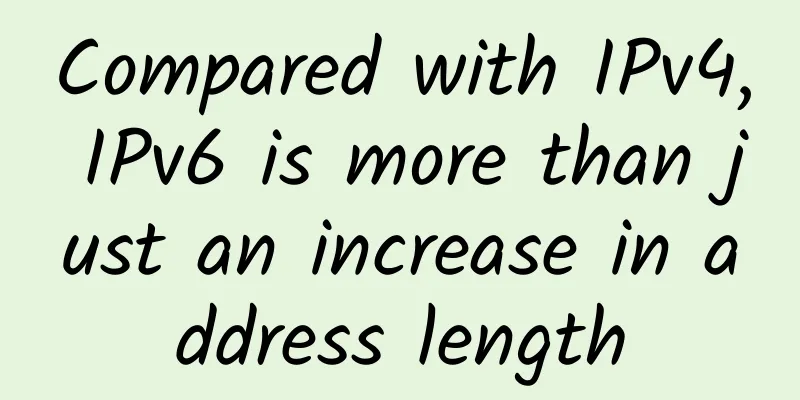How to quickly optimize your home Wi-Fi in 30 minutes? Alibaba engineers have a trick

|
Abstract: Modern people cannot live without mobile phones, and even more so with Wi-Fi. Many students often complain about the poor Wi-Fi at home, which is laggy and slow when playing games or watching videos. Ali Mei's Introduction: Modern people cannot live without mobile phones, and even more so with Wi-Fi. Many students often complain about the poor Wi-Fi at home, which is laggy and slow when playing games and watching videos. In response to common questions and various "rumors" in the market, today we specially invited Alibaba engineer Yichao to do a comprehensive sorting and classification for everyone, hoping that every student can enjoy a silky smooth Wi-Fi experience. PrefaceThe home network is an integrated link from the export broadband to the terminal, which is divided into the following parts. Egress area: The telecom operator's home line finally delivers an Ethernet cable to the household side, including the home fiber optic (PON) terminal and the egress router, which mainly provides "NAT" (realizes the address conversion and translation of the home [private network] IP address to the operator's [public network] IP address), PPPOE dial-up, security access control and other functions. Core area: This area is the center point for all network devices to connect and is the backbone channel of the home network. It is usually a router or switch, which implements network segment routing interconnection, DHCP, Internet behavior management, speed limit and security functions. It also provides direct connection with wired devices and provides large traffic input and output capabilities, such as home NAS, surveillance video recorders, server connections, etc. Access area: It is the most user-oriented area of the network, but it is a network edge device that realizes the interconnection function with terminals (mobile phones, computers, IOT devices, etc.), usually wireless routers (APs) and switch wired ports. Refer to the above figure, the network is an overall project, and any bottleneck in any link will affect the "feeling". From the historical consulting issues, 90% of them are related to Wi-Fi signal quality, so here we focus on sharing with you the general technical principles and optimization methods on the Wi-Fi signal side to achieve the purpose of quickly improving Wi-Fi quality. The specific device configuration method can be mapped to the manual of each wireless router (AP) purchased by the students. Wi-Fi network failure symptomsSymptom 1 : Network disconnection, packet loss, lag, speed fluctuations, large jitters, and instability. Brief analysis: From the client's perspective, the quality of the network is directly reflected in the negotiation rate: because the negotiation rate is a comprehensive reflection of a series of RF parameters such as signal value, noise, interference, retransmission rate, etc. The fault is shown in the figure below (the network rate is unstable and jumps sharply within 1 minute). Symptom 2 : The Internet speed is very slow. Although a high external bandwidth and a high-power wireless router were purchased for capacity expansion, the speed still did not improve. Brief analysis: The problem lies in the Wi-Fi signal. Some wireless router manufacturers vigorously promote their products with high transmission power and can pass through walls, but ignore the terminal transmission power backhaul capability and roaming switching issues. Since the wireless router has a high transmission power and thus a strong signal, the terminal far from the router receives a full signal, but the distance or obstruction has exceeded the power range of the terminal's own transmission power backhaul. As shown in the figure below (the signal is close to full, but the negotiated rate is only 13Mbps). Symptom 3 : The mobile phone is in bedroom A, but it is often connected to the router in bedroom B far away. Although the screen shows that the signal is good, the actual network speed is "slow". Brief analysis: When the transmission power is too high and multiple wireless routers (APs) are installed at home, the terminal will basically stick and not roam. As shown in the following figure (blue is the currently connected AP), the computer is not connected to the wireless router with the strongest signal and closest to itself. Wi-Fi signal optimization principles1. Appropriately reduce the wireless router transmission power (17db, 50mw), and the reference indoor communication radius is 8-12 meters. 1. Two-way communication: Only one transmission tower is needed for a city radio broadcasting base station to cover the whole city, and only one loudspeaker is needed to cover the whole village. Their core advantages are all one-way communication. When we need two-way communication, such as making a phone call, we need to convert the sound picked up by the mobile phone MIC into an electric wave signal through sampling and compression and return it to the communication base station. At this time, it is restricted by the power of the mobile phone, that is, the effective transmission distance. Because the transmission power of the mobile phone is relatively small, mobile operators need a large number of communication base stations with cellular coverage, in order to receive effective feedback from the terminal and realize effective two-way communication. Wi-Fi is also an air medium communication technology, and the same principle applies. When the power of both parties in communication does not match, frequent interruptions and low rates will occur during Wi-Fi use. Therefore, the Wi-Fi router must match the effective working capacity of the terminal power. It is recommended to configure the transmission range to 14-17db so that both parties in communication can reach 100% rate negotiation. On the contrary, the higher the power of the Wi-Fi router, the longer the transmission distance, the lower the terminal connection rate and the worse the communication quality. According to China's national standard, the maximum transmission power of indoor Wi-Fi is 20db (100mw). The power parameter comparison table is as follows: 2. Cellular design: In principle, the closer the distance between the two parties in radio communication, the higher the bandwidth that can be negotiated between the two parties. The currently commonly used 5GHZ Wi-Fi protocol mainly operates in the 5.2GHZ~5.8GHZ frequency band, which can modulate a theoretical communication bandwidth of up to 1.3Gbps, and is mainly designed for indoor small cellular scenarios. In addition, considering the mobile phone antenna and appearance, battery life, power consumption, etc., most mobile phones on the market currently have a power of about 10-14db, as shown in the figure below. Most laptop Intel Wi-Fi network cards are in the range of 12-14db. 3. Communication distance: Taking the iPhone 6 as an example, in the Wi-Fi 5GHZ frequency band without any obstruction in the indoor environment, the communication distance is 8-12 meters at full negotiation rate, and the communication distance for maintaining connection is 70-90 meters. 2. Reduce the number of wireless routers, select a suitable center point in the house, and install them on the ceiling or desktop to ensure that the line of sight between the terminal and the router is unobstructed, or at most through one wall. 1. Choose a good location: If conditions permit, try to install it on the ceiling or place it high on the desktop. This ensures coverage quality and saves floor space. If you have requirements for aesthetics, you can buy a router that matches the decoration style or paint it yourself. Avoid interference: Keep away from strong magnetic fields at least 0.5 meters away (microwave ovens, induction cookers, high-voltage equipment, large-screen TVs, etc.). Avoid obstructions: Do not hide the router in a low-voltage box, especially a metal box or wooden cabinet, cloakroom, storage room, corner, or on the ground. 2. Perfect network ports: 100% blind spot-free and high-quality full-speed Wi-Fi is based on perfect wired ports in each room. Although it can be expanded through wireless bridging and other methods, the communication quality will be greatly sacrificed. 3. Reduce the number of devices: The more wireless routers there are, the higher the probability of terminal roaming, disconnection, and reconnection. This is directly proportional. The probability of protocol conflicts (such as DHCP coverage conflicts, co-frequency interference, etc.) during operation will also increase relatively, and the network architecture will become more complex. Therefore, the number of devices should be reduced as much as possible, and simplicity should be achieved as much as possible. 4. Wireless relay: In large apartments (Dabieye) with imperfect weak power grid ports, in order to reduce construction and affect the visual impact of the interior, we can choose "bridge relay" or MESH for easy deployment. However, when using relay MESH and other solutions, using wireless bridge interconnection will not be so "cool" in terms of use. The reason is simple and obvious. There will be bandwidth loss for each connection, which will eventually reduce the overall bandwidth. The bandwidth decreases by 50% for each additional jump of the bridge, so we usually design bridges: at most one level of sub-device is attached. 5. Power cat: For large households (Dabieye) with imperfect weak power grid ports (wired), the "power cat" method can also be considered to reduce construction. It uses traditional wires and adopts frequency band technology to transform wires into communication lines. As long as the "power cat" is deployed in the wire system in the same meter area, the purpose of expanding the communication network can be achieved. However, in terms of electromagnetic characteristics, wires are not optimized for high-frequency signal transmission. They cannot be compared with special communication cables such as optical cables, twisted pairs, and coaxial cables. They have disadvantages such as large interference and signal integrity, and are easily affected by large current fluctuations during peak power consumption or unstable voltage. Therefore, this implementation method has inherent defects in communication quality and stability, and there are more fault points. If the network stability requirements are high, this method is not recommended. 3. Home Wi-Fi is configured with 5GHZ frequency band and 40MHZ bandwidth, while IOT devices and visitors use 2.4G frequency band. 1. Frequency band selection: The 2.4Ghz frequency band has good penetration, but there are only 3 available channels, as shown in the figure below. Compared with the 5G frequency band, its frequency band is narrow, the rate is low, and the interference is large. It is recommended to reserve it for smart home and IOT devices and visitors, and configure a separate SSID and security policy. The 5 GHZ band provides more available channels in principle. There are 13 available channels in the licensed frequency band in China, so using 5GHZ can conditionally perform multi-channel bonding to obtain higher bandwidth. 2. Channel bonding: Wider channel bandwidth can achieve higher communication bandwidth. For ordinary Intel 802.11ac network cards in laptops, 20Mhz=173Mbps, 40Mhz=400Mbps, and 80Mhz=866Mbps are used. However, this is a double-edged sword. Wider channels are more susceptible to interference, which increases latency. Therefore, we abandon 20MHZ and 80MHZ and use 40Mhz as a compromise. The schematic diagram is as follows: 3. Channel selection: Use tool software (specific software names will be mentioned below) to scan for idle channels and configure them to the wireless router. Each router in the home should be configured to a different channel to avoid co-channel interference. Network Optimization Methods 1. Examples of Wi-Fi location and spectrum design for different apartment types 1. Small apartment: 2. Medium-sized apartment 3. Large apartment 4. For villas, you can refer to the above house types according to the single-floor layout. 2. Network architecture design: It is recommended to refer to the introduction of this article for the design of the home network architecture and perform a layered design. We often have questions like: 1. My family uses 100M ADSL bandwidth, why can't the speed measured by computer and mobile phone reach such a high level? You can refer to the architecture diagram in the preface to sort out the bottleneck location for targeted optimization. In addition, pay attention to the conversion of large and small bytes. The network home bandwidth is usually calculated in small bytes (100Mbps/S bandwidth, the actual file download speed is 10MBps/S). You can use a computer to test the speed at www.speedtest.net to confirm whether the home bandwidth meets the standard. Export bandwidth calculation: It is calculated based on the superposition of all terminal traffic at the same time period in the home. Under normal circumstances, the traffic of HDTV is about 4MBps, the ordinary video service of the computer is 2MBps, and the mobile phone video is usually 1MBps. If there is a large traffic demand such as P2P download and upload, the calculation is superimposed according to the application demand. Key access resources: Popular hotspots and APP application traffic, which can be met by the three major operators. If you have special needs, such as you need to frequently connect with a home in another city through video with large traffic, you can choose the one with the highest hop count based on the hop count of the target IP on different operators (you can use the tracert xxxx command on the computer to track the hop count and delay). 2. My home network is often disconnected, some devices cannot access the Internet, and an exclamation mark is displayed on the terminal network connection icon. What is the reason? Most of these problems are caused by DHCP protocol conflicts. For non-gateway routers, the upstream network cable should be connected to the LAN port rather than the WAN port, and functions such as DHCP that conflict with the core layer must be turned off, and the router should only be used for wireless signal transmission. 3. Network Security Security is a whole software and hardware system that includes all devices involved in the home network. There needs to be a balance between security and ease of use. You can make a choice based on your needs. You can refer to the following three levels of design. General prevention: Differentiate the network segments of home Wi-Fi and guest Wi-Fi, isolate the routes on core devices, configure WPA2 AES CCMP strong encryption, and update the password regularly. Relative confidentiality: It is recommended to hide the home Wi-Fi SSID. Of course, technically, the SSID name can be captured by packet capture, so other matching strategies need to be added. Configure WPA2 AES CCMP strong encryption, turn off the DHCP function, use static address allocation, add MAC address binding or restrict MAC access and other strategies and their superposition. Strict confidentiality: Based on the first two projects, purchase firewalls of the corresponding level according to your own needs, strictly design inbound and outbound data traffic strategies, and take strict security precautions for the system security of all devices in your home, such as regularly updating router and AP device software to make up for software security and functional vulnerabilities. We often have questions like: My Wi-Fi password is quite complicated and I can't even remember it myself, so why can others still use it? How can I solve it? If a mobile phone with an "*** key" type APP has ever accessed the network, this type of APP will share the password to the cloud or its APP configuration end. Then, no matter how complicated the password setting at home is, it cannot withstand such a broadcast. We strictly control family members from installing such APPs, and refer to the strategy introduced earlier for deployment: distinguishing SSIDs by visitors and family members can also effectively reduce the impact of such problems, but once a "freeloading" incident occurs, it is recommended to change the password immediately. 4. Equipment Selection Choose according to your apartment needs. For example, for a small apartment, you can choose a wireless router (equivalent to a router switch and wireless router all-in-one). Extra/large apartments can be divided into zones/layers. We often have questions like: 1. The prices of home wireless routers vary greatly. What is the difference between them? The relevant indicators consider the following factors: 2.4&5G dual-band, 802.11ac, Gigabit Ethernet, stable operation time at startup, high concurrent traffic stability, concurrent number of multiple terminals, moisture-proof, high temperature resistance and high-altitude drop protection, software iteration after-sales support capabilities, antenna array design and sensitivity, software functions, etc. 2. There are many strategies for enhancing Wi-Fi signals on the Internet. Which one is the most practical? Don’t be superstitious about high transmission power. Any so-called wall-penetrating king is a scam (refer to the optimization principles section above). Don’t try to increase the power of the router, install cans, add amplifiers, and add antennas. Doing so will indeed enhance the signal on the transmitter side. However, "effective" communication is two-way. If only the power of the transmitter side is enhanced, and the power of the terminal and mobile phone side is very low, there will be a power mismatch phenomenon. The signal at a distance from the transmitter is indeed full, but the data packets sent back by the mobile phone side cannot be returned. This is actually of no help to communication and interferes with the quality of the global Wi-Fi signal deployment. (As shown in the figure below, the green signal range is fixed, and the extended signal is the red signal of poor quality) 3. Are the more antennas, the better? Does the number of antennas have anything to do with wall penetration? In theory, yes. If all wireless devices are compared under the same specification standard, the more antennas, the higher the sensitivity, and the better the wall penetration performance. But in reality, due to the influence of product hardware design (price cost limit) and antenna materials, there is no absolute conclusion. It depends on the product. The sensitivity of a router with a built-in antenna is not necessarily worse than that of an external antenna. Therefore, the number of antennas can only be regarded as one of the reference indicators. 4. If you plan to use bridging to cover a large apartment, how should you choose the equipment? As mentioned above, try not to choose this coverage method. If you must use this method, you can consider using Tmall routers and DingTalk routers, which have large air interface capacity, stable operation, and simple configuration. 5. Effect Test Related tools: For PC, you can choose Insider, WirelessMon, Wireless Netview, etc., depending on the system. The mobile phone terminal can choose speed test, WiFi analyzer, WiFi Analyzer, etc. It is very simple and easy to use. Test method: Use the above tool software to perform signal and bandwidth tests in the target coverage area, perform gateway ping tests, and browse large domestic Internet sites. Related indicators: In the target coverage area, the received signal strength is greater than or equal to -75dBm; in areas with voice and video services, the received signal is greater than or equal to -67dBm; Ping the gateway, the packet size is 1500 bytes, the number of ping packets is 100, the delay is no more than 100ms, and the packet loss rate of the ping packet is no more than 1%; the roaming switching success rate is no less than 90%, and the switching time between APs is pinged to the gateway record, and a maximum of 1 packet loss is allowed. When the computer is connected to Wi-Fi, use www.speedtest.net to test the network speed and it can reach the export bandwidth value. When the computer is connected to Wi-Fi, click on domestic hot spots 20 times, and the access success rate is not less than 100%; the display delay for visiting large domestic sites is no more than 2 seconds. What other methods do you have for optimizing your home Wi-Fi? Feel free to share your ideas in the comments section. |
Recommend
TNAHosting: 12G memory 500GB hard disk OpenVZ monthly payment from $5, 4G memory KVM monthly payment of $5
Some businesses give people the impression that t...
China Unicom begins deploying 2G network and stops all services
2G outdated communication technology will inevita...
HOSTEROID: €14/year - 2GB/25GB/750GB@1Gbps/UK (London) VPS
HOSTEROID recently released two special annual pa...
Wuhan Aidi Group chooses Feiyuxing Wireless to achieve 30,000 square meters of warehouse coverage
Customer Introduction Wuhan Aidi Group Co., Ltd. ...
You know IPv4, but how much do you know about the new IPv6?
According to Google user statistics, as of June t...
AkkoCloud: CN2 GIA lines in the US/Germany/UK, starting at 299 yuan per year, 300-600Mbps bandwidth
AkkoCloud is a Chinese VPS service provider estab...
Huawei and TestBird sign a memorandum of cooperation to promote the development of cloud testing ecosystem
[September 11, 2017] On September 7, during HUAWE...
A Brief Analysis of Bluetooth MESH Broadcasting
Labs Guide Bluetooth mesh technology is implement...
edgeNAT September Promotion: 20% off for monthly VPS and 30% off for annual VPS starting from 48 yuan/month, in the US/Hong Kong/Korea data centers
edgeNAT has launched a promotional event for the ...
China Mobile's 5G planning goals have been clarified
At the online forum "How to 'accelerate&...
HostKvm Hong Kong B Zone 40% off, $5.1/month KVM-2G memory/40G hard disk/1Gbps bandwidth
HostKvm is a Hong Kong VPS provider founded in 20...
Talking about the "security gate" of Facebook and Google: the "cheese" and "traps" of SD-WAN
On September 28, hackers used Facebook's secu...
5 reasons why SMBs shouldn’t upgrade to 5G yet
The excitement around 5G continues, and for good ...
How 5G frequencies affect range and speed
Experts say that while 5G technology is a huge im...
Will the laser in a broken optical fiber harm us?
Optical fiber is an important component of commun...





![[Black Friday] SiliCloud: Los Angeles VPS starts at $18 for two years, Japan VPS starts at $46 per year, optional CN2 line](/upload/images/67cabffb74a20.webp)



